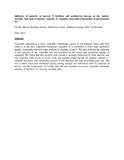| dc.contributor.author | Cecilia, Moraa Onyango | |
| dc.contributor.author | Jeremy, Harbinson | |
| dc.contributor.author | Jasper, Kathenya Imungi | |
| dc.contributor.author | Olaf, Van Kooten | |
| dc.date.accessioned | 2013-02-22T05:55:23Z | |
| dc.date.issued | 2011 | |
| dc.identifier.citation | lnt. J Postharvest Technology and Innovation, VoL 2. No.2. | en |
| dc.identifier.uri | http://erepository.uonbi.ac.ke:8080/xmlui/handle/123456789/10673 | |
| dc.description.abstract | Vegetable amaranth is a leary vegetable traditionally grown in sub-Saharan Africa and Asia where it is the most consumed traditional vegetable. It is considered to have high nutritional quality, containing relatively large amounts of vitamins A and C. We have assessed the influence of the maturity of the vegetable and soil nutrition on the visual and nutritional quality of amaranth. We found that leaf ascorbic acid content is strongly influenced by both maturity and soil nutrition, with leaves of seven week old matured plants having the highest content, (}-carotene increased with increasing amount of soil
nitrogen and with increasing plant age. The loss of both visual and nutritional quality during storage was influenced more by maturity at harvest and the temperature of storage than the soil nutrition.Keywords: vegetable amaranth; maturity; N fertiliser; l3-carotcne; ascorbic acid. | en |
| dc.language.iso | en | en |
| dc.subject | Vegetable amaranth | en |
| dc.subject | Maturity | en |
| dc.subject | N fertiliser | en |
| dc.subject | Ascorbic acid | en |
| dc.title | Influence of maturity at harvest, N fertiliser and postharvest storage on dry matter, ascorbic acid and(.i-carotene contents of vegetable amaranth(Amaranthus hypochondriac us) | en |
| dc.type | Article | en |
| local.publisher | Food Science, Nutrition and Technology | en |

